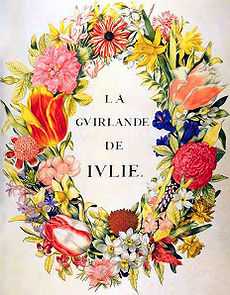Guirlande de Julie

| French literature |
|---|
| by category |
| French literary history |
| French writers |
|
| Portals |
|
The Guirlande de Julie (French pronunciation: [ɡiʁlɑ̃d də ʒyli], Julie's garland) is a unique French manuscript of sixty-two[1] madrigaux.[2][3]
The salon of Catherine de Vivonne, marquise de Rambouillet (1588–1665), wife of Charles d'Angennes, marquis de Rambouillet (1577–1652),[4] was the first and most brilliant Parisian literary salon of the first half of the 17th century, at its height between 1620 and 1645. The Hôtel de Rambouillet,[5] as it was called, was frequented by renowned précieuses, writers, nobles and "robins".
One of its habitués, Charles de Sainte-Maure, marquis de Montausier (1610–1690), had been in love since 1631 with Julie d'Angennes (1606–1671), the daughter of the marquis and marquise de Rambouillet. To charm her, he decided to give her an extraordinary present.
Montausier asked seventeen of the most talented poets of the time, all frequent visitors of the Hôtel de Rambouillet, to each write a madrigal in which a flower would sing the praises of Julie d'Angennes. These madrigaux were composed by writers as famous as Georges de Scudéry, Desmarets de Saint-Sorlin, Valentin Conrart, Jean Chapelain, Racan, Tallemant des Réaux, Robert Arnauld d'Andilly, Simon Arnauld de Pomponne, Arnauld de Corbeville, Montmor, Germain Habert, Colletet, Claude Malleville, Philippe Habert, le chevalier de Méré, Antoine Godeau, Pinchesne, Pierre Corneille (doubtful, according to Bibliothèque nationale de France) and the marquis de Rambouillet. Montausier himself wrote sixteen of the madrigals.[3]
Then the text was ornamentally written by the calligraphist Nicolas Jarry and the flower quoted in each poem painted by Nicolas Robert, while the binding was done by Le Gascon.[6] The final object turned out to be one of the most extraordinary manuscripts of the century and one of the highlights of the "précieuse" society.
Julie found the manuscript on her bed, upon awakening one morning of 1641[7] (see 1641 in poetry). However, she let Montausier wait another four years, until 1645, before accepting to marry him. Their engagement had lasted fourteen years.
After becoming the possession of the Crussol-d'Uzès family, the manuscript was sold several times. La Guirlande de Julie is now conserved at the département des manuscrits of the Bibliothèque nationale de France (French National Library). It was first published in 1729 (see 1729 in poetry), although several poems had already appeared in various collections.
References
- ↑ Although the majority of sources gives the number of sixty-two madrigals, Irène Frain, in her book La Guirlande de Julie published in collaboration with the Bibliothèque Nationale de France in 1991, gives the number of forty-one madrigals. Irène Frain discovered the original manuscript at the time of its acquisition by the BnF.
- ↑ La Guirlande de Julie, augmentée de pièces nouvelles publiée sur le Manuscript original avec une notice de Gaignières et de Bure et des Notes par Ad van Bever, Sansot Libraire, Paris, 1907:
- ↑ 3.0 3.1 Jules Tellier, "La Guirlande de Julie" Le Parti national, November 27, 1887 (French)
- ↑ http://web.genealogie.free.fr/Les_dynasties/Les_dynasties_celebres/France/Dynastie_d'Angennes.htm. Scroll down to VIII, last on page.
- ↑ http://www.encyclopedia.com/doc/1E1-RamblltCV.html.
- ↑ http://www.aboutbookbinding.com/FamousBinders/De-Thou-and-LE-Gascon-3.html.
- ↑ G. Lenotre, Le Château de Rambouillet, six siècles d'Histoire, Calmann-Lévy, Paris, 1930. Réédition, Denoël, Paris, 1984, pp. 27-29
Bibliography
- Frain, Irène, La Guirlande de Julie, Robert Laffont, Bibliothèque Nationale, Paris, 1991, ISBN 2-221-06819-6
- Lenotre, G., Le Château de Rambouillet, six siècles d'Histoire, Denoël, Paris, 1984, ISBN 2-207-23023-6..